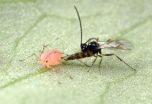(Press-News.org) GAINESVILLE, Fla. --- As scientists continue developing climate change projection models, paleontologists studying an extreme short-term global warming event have discovered direct evidence about how mammals respond to rising temperatures.
In a study appearing in Science Feb. 24, researchers from eight institutions led by scientists from the University of Florida and University of Nebraska found a correlation between temperature and body size in mammals by following the evolution of the earliest horses about 56 million years ago: As temperatures increased, their body size decreased.
"Horses started out small, about the size of a small dog like a miniature schnauzer," said co-author Jonathan Bloch, associate curator of vertebrate paleontology at the Florida Museum of Natural History on the UF campus. "What's surprising is that after they first appeared, they then became even smaller and then dramatically increased in size, and that exactly corresponds to the global warming event, followed by cooling. It had been known that mammals were small during that time and that it was warm, but we hadn't understood that temperature specifically was driving the evolution of body size."
Sifrhippus, the earliest-known horse, first appeared in the North American fossil record during the Paleocene-Eocene Thermal Maximum. During this 175,000-year climate event, increased concentrations of carbon dioxide in the atmosphere and oceans caused average global temperatures to rise 10 to 20 degrees. By analyzing the size and isotopes of fossils collected in Wyoming's Bighorn Basin, researchers traced the evolution of Sifrhippus from an estimated 12-pound animal that shrank during a 130,000-year period about 30 percent to 8.5 pounds -- the size of a small house cat -- then increased to about 15 pounds during the next 45,000 years.
"This is the highest-resolution terrestrial record of its kind from anywhere in the world and it shows how climate changed in Wyoming at that time," said lead author Ross Secord, who began geochemical analysis of the horse teeth and other mammals as a postdoctoral researcher with Bloch before joining the University of Nebraska-Lincoln in 2008. "When Jon and I started plotting oxygen data from the mass spectrometer, we could immediately see that the shifts in size of horses and temperature were mirror images of each other."
Bloch said the project began about seven years ago when former UF student and study co-author Stephen Chester, now an anthropology doctoral candidate at Yale University, measured horse teeth that seemed to be too large for their age and became smaller through the geologic section. The findings raise important questions about how animals might respond to future rapid climate change.
"We're seeing about a third of the mammals getting smaller and some of them getting a lot smaller, by as much as half of their original body size," Secord said. "Because warming happened much slower during the Paleocene-Eocene Thermal Maximum, mammals had more time to adjust their body size. So, it's not clear that we're going to see the same thing happening in the near future, but we might."
Philip Gingerich, who first recorded the phenomenon of decreasing body size during the Paleocene-Eocene Thermal Maximum in 1989, said the study documentation clearly demonstrates the relationship between temperature and body size. He agrees this may occur as a result of current warming patterns.
"I joke about this all the time -- we're going to be walking around 3 feet tall if we keep going the way we're going," said Gingerich, a researcher at the University of Michigan and director of its Museum of Paleontology. "Maybe that's not all bad and if that's the worst it gets, it will be fine. You can either adapt, or you go extinct, or you can move, and there's not a lot of place to move anymore, so I think it's a matter of adaptation and becoming smaller."
Researchers also analyzed correlations with aridity and carbon dioxide levels but found temperature to be the most likely driving factor in body size. Although little is known about how animals arrived in North America at that time, the Paleocene-Eocene Thermal Maximum is a significant event in geologic time in terms of mammalian history, Bloch said.
"The PETM is really important because it marks the beginning for the first appearance of several major groups of mammals, including crown-group primates (ancestors of modern primates) and the first even- and odd-toed modern ungulates (mammals with hooves)," Bloch said. "This sets the scene for the entire diversity of animals we see on the planet today."
###
Study co-authors include Doug Boyer of Brooklyn College, Aaron Wood of South Dakota School of Mines and Technology and the Florida Museum, Scott Wing of the Smithsonian Institution National Museum of Natural History, Mary Kraus of the University of Colorado, Francesca McInerney of Northwestern University and John Krigbaum of UF.
END
More than three quarters (77%) of cancer patients who first present to their family doctors (GPs) with suspicious symptoms are referred to hospital after only one or two consultations, a new study has found. However, the new research also shows a wide variation in the number of times a cancer patient sees their general practitioner before they are referred to a specialist, with the most pre-referral consultations occurring when the cancer was one of the less common types, or when the patient was either female, young, or an older person from an ethnic minority. The research ...
A compound in citrus fruits may reduce your stroke risk, according to research reported in Stroke: Journal of the American Heart Association.
This prospective study is one of the first in which researchers examine how consuming flavonoid subclasses affects the risk of stroke. Flavonoids are a class of compounds present in fruits, vegetables, dark chocolate and red wine.
"Studies have shown higher fruit, vegetable and specifically vitamin C intake is associated with reduced stroke risk," said Aedín Cassidy, Ph.D., the study's lead author and professor of nutrition at ...
Researchers at the RIKEN-MIT Center for Neural Circuit Genetics have discovered an answer to the long-standing mystery of how brain cells can both remember new memories while also maintaining older ones.
They found that specific neurons in a brain region called the dentate gyrus serve distinct roles in memory formation depending on whether the neural stem cells that produced them were of old versus young age.
The study will appear in the March 30 issue of Cell and links the cellular basis of memory formation to the birth of new neurons -- a finding that could unlock ...
Stavros "LOTSandLOTS" Ioannou, one of the latest up and coming poker players to be sponsored and mentored by Badbeat.com, has begun with a winning streak that started with two MTTs then, the following week, 2nd in the EUR5k guaranteed EUR50 Turbo on Poker Time and 3rd in the $10k Guaranteed $5 Rebuy on Poker Encore for $2.1k. Now bankrolled and tutored by Badbeat.com, prospects look good for the young poker player.
"My first day with Badbeat.com was a good one -- I played 6 MTTs in total and final tabled 3/6 winning two of them," said Ioannou. "My ...
A new study reports that the disintegration of the Maya Civilization may have been related to relatively modest reductions in rainfall.
The study was led by Professors Martín Medina-Elizalde of the Yucatan Center for Scientific Research in Mexico and Eelco Rohling of the University of Southampton in the UK. Professor Rohling says:
"Our results show rather modest rainfall reductions between times when the Classic Maya Civilization flourished and its collapse – between AD 800-950. These reductions amount to only 25 to 40 per cent in annual rainfall. But they were large ...
Nursing home residents over the age of 65 who take certain antipsychotic medication for dementia are at an increased risk of death, suggests a research paper published today on bmj.com.
The Harvard Medical School study, the largest ever undertaken among US nursing home residents, looked at 75,445 older nursing home residents from 45 US states between 2001 and 2005. All nursing home residents studied were 65 and over. Risks of mortality were looked at during a six month period.
The US Food and Drug Administration (FDA) warned in 2005 that atypical antipsychotic drugs ...
In the war between parasite and host, the parasitic wasp, Aphidius ervi, and the pea aphid, Acyrthosiphon pisum, are locked in a battle for survival. New research published in BioMed Central's open access journal BMC Biology shows that this cunning parasite sniffs out differences between protected and unprotected aphids, and alters its egg-laying strategy, in order to overwhelm aphid defenses and ensure survival of wasp offspring.
The wasp, A. ervi, lays an egg inside the pea aphid, where the egg hatches and converts the aphid's insides into a wasp nursery. The wasp ...
Spacious new homes on large, hillside homesites in Fair Oaks Ranch are coming to Santa Clarita at Crest View, where Los Angeles homebuilder Pardee Homes has set Saturday, March 3 for grand opening festivities. The Crest View sales center will open at 10 a.m. and home shoppers are invited to enjoy self-guided tours of 4 fully decorated model homes.
Grand opening visitors can also take in a lively session with Sandy Krogh of Culinary Consultants. Demonstrating Crest View's upscale G.E. appliance line in a model home kitchen, Sandy will present delicious and easy springtime ...
Age-related macular degeneration (AMD) is one of the leading causes of blindness worldwide, especially in developed countries, and there is currently no known treatment or cure or for the vast majority of AMD patients. New research published in BioMed Central's open access journal Genome Medicine has identified genes whose expression levels can identify people with AMD, as well as tell apart AMD subtypes.
It is estimated that 6.5% of people over age 40 in the US currently have AMD. There is an inheritable genetic risk factor but risk is also increased for smokers and ...
In recent years, a number of controversial claims have been made about the female mammal's egg supply – that it is renewed over her adult lifetime (as opposed to the conventional understanding that she is born with all of her eggs), and that the source of these eggs is stem cells that originate in the bone marrow. Now, Weizmann Institute scientists have disproved one of those claims and pointed in new directions toward resolving the other. Their findings, based on an original method for reconstructing lineage trees for cells, were published online today in PLoS Genetics.
The ...



